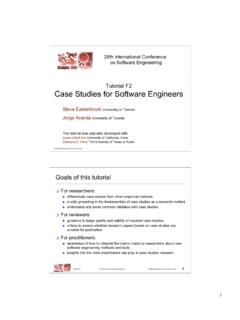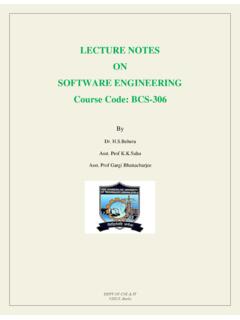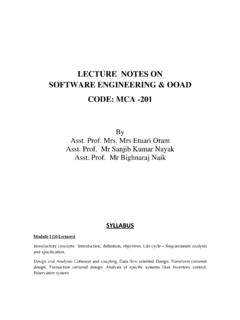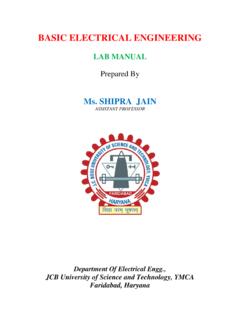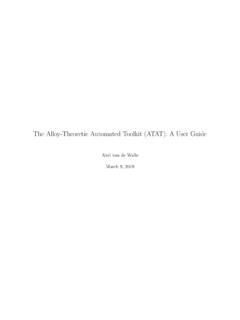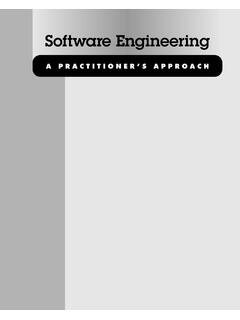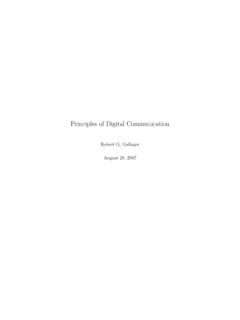Transcription of Software Engineering - Tutorialspoint
1 Software Engineering Tutorial Simply Easy Learning About the tutorial Software Engineering Tutorial This tutorial provides you the basic understanding of Software product, Software design and development process, Software project management and design complexities. At the end of the tutorial you should be equipped with well understanding of Software Engineering concepts.
2 Audience This tutorial is designed for the readers pursuing education in Software development domain and all enthusiastic readers. Prerequisites This tutorial is designed and developed for absolute beginners. Though, awareness about Software systems, Software development process and computer fundamentals would be beneficial. Copyright & Disclaimer Copyright 2014 by Tutorials Point (I) Pvt. Ltd. All the content and graphics published in this e-book are the property of Tutotorials Point (I) Pvt. Ltd. The user of this e-book is prohibited to reuse, retain, copy, distribute or republish any contents or a part of contents of this e-book in any manner without written consent of the publisher.
3 We strive to update the contents of our website and tutorials as timely and as precisely as possible, however, the contents may contain inaccuracies or errors. Tutorials Point (I) Pvt. Ltd. provides no guarantee regarding the accuracy, timeliness or completeness of our website or its contents including this tutorial. If you discover any errors on our website or in this tutorial, please notify us at i Table of Contents Software Engineering TUTORIAL .. I AUDIENCE .. I PREREQUISITES .. I COPYRIGHT & DISCLAIMER .. I Software OVERVIEW .. 1 DEFINITIONS .. 1 Software EVOLUTION .. 2 Software EVOLUTION LAWS .. 3 E-TYPE Software EVOLUTION.
4 3 Software PARADIGMS .. 4 Software Development Paradigm .. 4 Software Design Paradigm .. 5 Programming Paradigm .. 5 NEED OF Software Engineering .. 5 CHARACTERISTICS OF GOOD Software .. 6 Operational .. 6 Transitional .. 6 Maintenance .. 6 Software DEVELOPMENT LIFE 8 SDLC ACTIVITIES .. 8 Communication .. 8 Requirement Gathering .. 8 Feasibility Study .. 9 System Analysis .. 9 Software Design .. 9 Coding .. 9 Testing .. 9 Integration .. 10 Implementation .. 10 Operation and Maintenance .. 10 Software DEVELOPMENT PARADIGM .. 10 Waterfall Model .. 10 Iterative Model .. 11 Spiral Model .. 12 V model .. 12 Big Bang Model .. 14 Software PROJECT MANAGEMENT.
5 15 Software 15 NEED OF Software PROJECT MANAGEMENT .. 15 Software PROJECT MANAGER .. 16 Managing People .. 16 ii Managing Project .. 17 Software MANAGEMENT ACTIVITIES .. 17 PROJECT PLANNING .. 17 SCOPE MANAGEMENT .. 17 PROJECT 18 PROJECT ESTIMATION TECHNIQUES .. 19 Decomposition Technique .. 19 Empirical Estimation Technique .. 19 PROJECT SCHEDULING .. 20 RESOURCE MANAGEMENT .. 20 PROJECT RISK MANAGEMENT .. 21 Risk Management Process .. 21 PROJECT EXECUTION AND 21 PROJECT COMMUNICATION MANAGEMENT .. 22 CONFIGURATION MANAGEMENT .. 23 Baseline .. 23 Change Control .. 23 PROJECT MANAGEMENT TOOLS .. 24 Gantt Chart .. 24 PERT Chart.
6 25 Resource Histogram .. 25 Critical Path Analysis .. 26 Software REQUIREMENTS .. 27 REQUIREMENT Engineering .. 27 REQUIREMENT Engineering PROCESS .. 27 Feasibility study .. 27 Requirement Gathering .. 28 Software Requirement Specification (SRS) .. 28 Software Requirement Validation .. 28 REQUIREMENT ELICITATION PROCESS .. 29 REQUIREMENT ELICITATION TECHNIQUES .. 29 Interviews .. 30 Surveys .. 30 Questionnaires .. 30 Task analysis .. 30 Domain Analysis .. 30 Brainstorming .. 30 Prototyping .. 31 Observation .. 31 Software REQUIREMENTS CHARACTERISTICS .. 31 Software REQUIREMENTS .. 31 Functional Requirements .. 32 Non-Functional Requirements.
7 32 USER INTERFACE REQUIREMENTS .. 33 Software SYSTEM ANALYST .. 33 Software METRICS AND MEASURES .. 34 iii Software DESIGN 36 Software DESIGN LEVELS .. 36 MODULARIZATION .. 37 CONCURRENCY .. 37 Example .. 37 COUPLING AND COHESION .. 38 COHESION .. 38 COUPLING .. 39 DESIGN VERIFICATION .. 39 Software ANALYSIS AND DESIGN TOOLS .. 41 DATA FLOW DIAGRAM .. 41 Types of DFD .. 41 DFD Components .. 41 Levels of DFD .. 42 STRUCTURE CHARTS .. 43 HIPO DIAGRAM .. 45 Example .. 46 STRUCTURED ENGLISH .. 47 Example .. 47 PSEUDO-CODE .. 48 Example .. 49 DECISION TABLES .. 49 Creating Decision Table .. 49 Example .. 50 ENTITY-RELATIONSHIP MODEL.
8 50 DATA DICTIONARY .. 51 Requirement of Data Dictionary .. 51 Contents .. 52 Example .. 52 Data Elements .. 52 Data Store .. 53 Data 53 Software DESIGN STRATEGIES .. 54 STRUCTURED DESIGN .. 54 FUNCTION ORIENTED DESIGN .. 55 Design 55 OBJECT ORIENTED DESIGN .. 55 Design 56 Software DESIGN APPROACHES .. 57 Top Down Design .. 57 Bottom-up Design .. 57 Software USER INTERFACE DESIGN .. 58 COMMAND LINE INTERFACE (CLI) .. 58 CLI Elements .. 59 iv GRAPHICAL USER INTERFACE .. 60 GUI Elements .. 60 Application specific GUI components .. 61 USER INTERFACE DESIGN ACTIVITIES .. 62 GUI IMPLEMENTATION TOOLS .. 64 Example .. 64 USER INTERFACE GOLDEN RULES.
9 64 Software DESIGN COMPLEXITY .. 67 HALSTEAD'S COMPLEXITY 67 CYCLOMATIC COMPLEXITY MEASURES .. 68 FUNCTION 70 External Input .. 70 External Output .. 71 Logical Internal Files .. 71 External Interface Files .. 71 External Inquiry .. 71 Software IMPLEMENTATION .. 74 STRUCTURED PROGRAMMING .. 74 FUNCTIONAL PROGRAMMING .. 75 PROGRAMMING STYLE .. 76 Coding Guidelines .. 76 Software DOCUMENTATION .. 77 Software IMPLEMENTATION CHALLENGES .. 78 Software TESTING OVERVIEW .. 80 Software VALIDATION .. 80 Software VERIFICATION .. 80 MANUAL VS AUTOMATED TESTING .. 81 TESTING APPROACHES .. 81 Black-box testing .. 82 White-box testing .. 82 TESTING 83 Unit Testing.
10 83 Integration Testing .. 83 System Testing .. 84 Acceptance Testing .. 84 Regression Testing .. 84 TESTING DOCUMENTATION .. 84 Before Testing .. 85 While Being Tested .. 85 After Testing .. 85 TESTING VS. QUALITY CONTROL & ASSURANCE AND AUDIT .. 86 Software MAINTENANCE OVERVIEW .. 87 TYPES OF MAINTENANCE .. 87 COST OF MAINTENANCE .. 88 v Real-world factors affecting Maintenance Cost .. 88 Software -end factors affecting Maintenance Cost .. 89 MAINTENANCE ACTIVITIES .. 89 Software RE- Engineering .. 90 Re- Engineering Process .. 91 Reverse Engineering .. 92 Program Restructuring .. 92 Forward Engineering .. 92 COMPONENT REUSABILITY.










